Effects of Ganjianglingzhu Decoction on Lean Non-Alcoholic Fatty Liver Disease in Mice Based on Untargeted Metabolomics
Abstract
1. Introduction
2. Results
2.1. The Analysis of GJLZ Compositions
2.2. Evaluation of the Lean NAFLD Mode
2.2.1. Body Weight of Mice
2.2.2. Liver Histology
2.2.3. Changes in Serum Index of Mice
2.3. Effects of GJLZ on Body Weight
2.4. Effects of GJLZ on Liver Morphology
2.5. Effects of GJLZ on Serum Index
2.6. Antioxidative Effects of GJLZ
2.7. Untargeted Metabolomics Analysis
2.7.1. Quality Control
2.7.2. Cluster Analysis
2.7.3. Metabolite Pathway Enrichment Analysis
2.8. Spearman Correlation Analysis of Serum Biochemical Indicators, Liver Antioxidant Indicators, and Differential Metabolites
3. Discussion
4. Materials and Methods
4.1. Preparation of GJLZ Decoction
4.2. Component Analysis of GJLZ Decoction
4.3. Mouse Preparation and Sampling
4.4. Histological Analysis of Liver Tissue
4.5. Serum Biochemical and Liver Oxidative Stress Indicator Analysis
4.6. Untargeted Metabolomics Analysis
4.6.1. Metabolite Extraction
4.6.2. UPLC–MS/MS Analysis
4.6.3. Bioinformatics Analysis
4.7. Statistical Analysis
5. Conclusions
Supplementary Materials
Author Contributions
Funding
Institutional Review Board Statement
Informed Consent Statement
Data Availability Statement
Conflicts of Interest
Abbreviations
References
- Riazi, K.; Azhari, H.; Charette, J.H.; Underwood, F.E.; King, J.A.; Afshar, E.E.; Swain, M.G.; Congly, S.E.; Kaplan, G.G.; Shaheen, A.-A. The prevalence and incidence of NAFLD worldwide: A systematic review and meta-analysis. Lancet Gastroenterol. Hepatol. 2022, 7, 851–861. [Google Scholar] [CrossRef]
- Friedman, S.L.; Neuschwander-Tetri, B.A.; Rinella, M.; Sanyal, A.J. Mechanisms of NAFLD development and therapeutic strategies. Nat. Med. 2018, 24, 908–922. [Google Scholar] [CrossRef]
- Chalasani, N.; Younossi, Z.; Lavine, J.E.; Charlton, M.; Cusi, K.; Rinella, M.; Harrison, S.A.; Brunt, E.M.; Sanyal, A.J. The diagnosis and management of nonalcoholic fatty liver disease: Practice guidance from the American Association for the Study of Liver Diseases. Hepatology 2017, 67, 328–357. [Google Scholar] [CrossRef]
- Zou, Z.Y.; Wong, V.W.S.; Fan, J.G. Epidemiology of nonalcoholic fatty liver disease in non-obese populations: Meta-analytic assessment of its prevalence, genetic, metabolic, and histological profiles. J. Dig. Dis. 2020, 21, 372–384. [Google Scholar] [CrossRef]
- Ahadi, M.; Molooghi, K.; Masoudifar, N.; Namdar, A.B.; Vossoughinia, H.; Farzanehfar, M. A review of non-alcoholic fatty liver disease in non-obese and lean individuals. J. Gastroenterol. Hepatol. 2020, 36, 1497–1507. [Google Scholar] [CrossRef]
- Tang, A.; Ng, C.H.; Phang, P.H.; Chan, K.E.; Chin, Y.H.; Fu, C.E.; Zeng, R.W.; Xiao, J.; Tan, D.J.H.; Quek, J.; et al. Comparative Burden of Metabolic Dysfunction in Lean NAFLD vs. Non-lean NAFLD—A Systematic Review and Meta-analysis. Clin. Gastroenterol. Hepatol. 2023, 21, 1750–1760.e1712. [Google Scholar] [CrossRef]
- Maier, S.; Wieland, A.; Cree-Green, M.; Nadeau, K.; Sullivan, S.; Lanaspa, M.A.; Johnson, R.J.; Jensen, T. Lean NAFLD: An underrecognized and challenging disorder in medicine. Rev. Endocr. Metab. Disord. 2021, 22, 351–366. [Google Scholar] [CrossRef]
- Feng, R.-N.; Du, S.-S.; Wang, C.; Li, Y.-C.; Liu, L.-Y.; Guo, F.-C.; Sun, C.-H. Lean-non-alcoholic fatty liver disease increases risk for metabolic disorders in a normal weight Chinese population. World J. Gastroenterol. 2014, 20, 17932–17940. [Google Scholar] [CrossRef]
- Chang, Y.; Cho, Y.K.; Cho, J.; Jung, H.-S.; Yun, K.E.; Ahn, J.; Sohn, C.I.; Shin, H.; Ryu, S. Alcoholic and Nonalcoholic Fatty Liver Disease and Liver-Related Mortality: A Cohort Study. Am. J. Gastroenterol. 2019, 114, 620–629. [Google Scholar] [CrossRef] [PubMed]
- Golabi, P.; Paik, J.; Fukui, N.; Locklear, C.T.; de Avilla, L.; Younossi, Z.M. Patients with Lean Nonalcoholic Fatty Liver Disease Are Metabolically Abnormal and Have a Higher Risk for Mortality. Clin. Diabetes 2019, 37, 65–72. [Google Scholar] [CrossRef] [PubMed]
- Zou, B.; Yeo, Y.H.; Nguyen, V.H.; Cheung, R.; Ingelsson, E.; Nguyen, M.H. Prevalence, characteristics and mortality outcomes of obese, nonobese and lean NAFLD in the United States, 1999–2016. J. Intern. Med. 2020, 288, 139–151. [Google Scholar] [CrossRef] [PubMed]
- Long, M.T.; Noureddin, M.; Lim, J.K. AGA Clinical Practice Update: Diagnosis and Management of Nonalcoholic Fatty Liver Disease in Lean Individuals: Expert Review. Gastroenterology 2022, 163, 764–774.e761. [Google Scholar] [CrossRef] [PubMed]
- Wang, R.-R.; Zhang, L.-F.; Chen, L.-P.; Wang, J.-Y.; Zhang, L.; Xu, Y.-S.; Yang, P.-L.; Ji, G.; Liu, B.-C.; Dominguez Perles, R. Structural and Functional Modulation of Gut Microbiota by Jiangzhi Granules during the Amelioration of Nonalcoholic Fatty Liver Disease. Oxidative Med. Cell. Longev. 2021, 2021, 2234695. [Google Scholar] [CrossRef]
- Yue, S.-R.; Tan, Y.-Y.; Zhang, L.; Zhang, B.-J.; Jiang, F.-Y.; Ji, G.; Liu, B.-C.; Wang, R.-R. Gynostemma pentaphyllum polysaccharides ameliorate non-alcoholic steatohepatitis in mice associated with gut microbiota and the TLR2/NLRP3 pathway. Front. Endocrinol. 2022, 13, 885039. [Google Scholar] [CrossRef] [PubMed]
- Dang, Y.; Xu, J.; Zhu, M.; Zhou, W.; Zhang, L.; Ji, G. Gan-Jiang-Ling-Zhu decoction alleviates hepatic steatosis in rats by the miR-138-5p/CPT1B axis. Biomed. Pharmacother. 2020, 127, 110127. [Google Scholar] [CrossRef] [PubMed]
- Xu, Y.; Zhang, L.; Zhang, Y.; Gao, S.; Zhuo, Y. Effect of Modified Ganjiang Lingzhu Decoction on Nonalcoholic Fatty Liver in Mice and Its Mechanism Based on Network Pharmacology and Experiments. World J. Integr. Tradit. West. Med. 2023, 18, 74–84. [Google Scholar] [CrossRef]
- Shinozuka, H.; Lombardi, B.; Sell, S.; Iammarino, R.M. Early histological and functional alterations of ethionine liver carcinogenesis in rats fed a choline-deficient diet. Cancer Res. 1978, 38, 1092–1098. [Google Scholar] [PubMed]
- Chen, F.; Esmaili, S.; Rogers, G.B.; Bugianesi, E.; Petta, S.; Marchesini, G.; Bayoumi, A.; Metwally, M.; Azardaryany, M.K.; Coulter, S.; et al. Lean NAFLD: A Distinct Entity Shaped by Differential Metabolic Adaptation. Hepatology 2020, 71, 1213–1227. [Google Scholar] [CrossRef] [PubMed]
- Wu, N.; Zhai, X.; Yuan, F.; Li, J.; Yu, N.; Zhang, F.; Li, D.; Wang, J.; Zhang, L.; Shi, Y.; et al. Fasting glucose mediates the influence of genetic variants of SOD2 gene on lean non-alcoholic fatty liver disease. Front. Genet. 2022, 13, 970854. [Google Scholar] [CrossRef]
- Wu, N.; Zhai, X.; Yuan, F.; Li, J.; Li, D.; Wang, J.; Zhang, L.; Shi, Y.; Ji, G.; He, G.; et al. Genetic variation in TBC1 domain family member 1 gene associates with the risk of lean NAFLD via high-density lipoprotein. Front. Genet. 2023, 13, 1026725. [Google Scholar] [CrossRef]
- Wu, N.; Li, J.; Zhang, J.; Yuan, F.; Yu, N.; Zhang, F.; Li, D.; Wang, J.; Zhang, L.; Shi, Y.; et al. Waist circumference mediates the association between rs1260326 in GCKR gene and the odds of lean NAFLD. Sci. Rep. 2023, 13, 6488. [Google Scholar] [CrossRef]
- Kim, D.; Kim, W.R. Nonobese Fatty Liver Disease. Clin. Gastroenterol. Hepatol. 2017, 15, 474–485. [Google Scholar] [CrossRef] [PubMed]
- Alshawsh, M.A.; Alsalahi, A.; Alshehade, S.A.; Saghir, S.A.M.; Ahmeda, A.F.; Al Zarzour, R.H.; Mahmoud, A.M. A Comparison of the Gene Expression Profiles of Non-Alcoholic Fatty Liver Disease between Animal Models of a High-Fat Diet and Methionine-Choline-Deficient Diet. Molecules 2022, 27, 858. [Google Scholar] [CrossRef] [PubMed]
- Carillon, J.; Rouanet, J.-M.; Cristol, J.-P.; Brion, R. Superoxide Dismutase Administration, A Potential Therapy Against Oxidative Stress Related Diseases: Several Routes of Supplementation and Proposal of an Original Mechanism of Action. Pharm. Res. 2013, 30, 2718–2728. [Google Scholar] [CrossRef] [PubMed]
- Ayala, A.; Muñoz, M.F.; Argüelles, S. Lipid Peroxidation: Production, Metabolism, and Signaling Mechanisms of Malondialdehyde and 4-Hydroxy-2-Nonenal. Oxidative Med. Cell. Longev. 2014, 2014, 360438. [Google Scholar] [CrossRef]
- Tan, Y.-Y.; Yue, S.-R.; Lu, A.-P.; Zhang, L.; Ji, G.; Liu, B.-C.; Wang, R.-R. The improvement of nonalcoholic steatohepatitis by Poria cocos polysaccharides associated with gut microbiota and NF-κB/CCL3/CCR1 axis. Phytomedicine 2022, 103, 154208. [Google Scholar] [CrossRef] [PubMed]
- Ye, Q.; Zou, B.; Yeo, Y.H.; Li, J.; Huang, D.Q.; Wu, Y.; Yang, H.; Liu, C.; Kam, L.Y.; Tan, X.X.E.; et al. Global prevalence, incidence, and outcomes of non-obese or lean non-alcoholic fatty liver disease: A systematic review and meta-analysis. Lancet Gastroenterol. Hepatol. 2020, 5, 739–752. [Google Scholar] [CrossRef] [PubMed]
- Schade, D.S.; Woodside, W.; Eaton, R.P. The role of glucagon in the regulation of plasma lipids. Metabolism 1979, 28, 874–886. [Google Scholar] [CrossRef] [PubMed]
- Gorden, D.L.; Myers, D.S.; Ivanova, P.T.; Fahy, E.; Maurya, M.R.; Gupta, S.; Min, J.; Spann, N.J.; McDonald, J.G.; Kelly, S.L.; et al. Biomarkers of NAFLD progression: A lipidomics approach to an epidemic. J. Lipid Res. 2015, 56, 722–736. [Google Scholar] [CrossRef]
- Kartsoli, S.; Kostara, C.E.; Tsimihodimos, V.; Bairaktari, E.T.; Christodoulou, D.K. Lipidomics in non-alcoholic fatty liver disease. World J. Hepatol. 2020, 12, 436–450. [Google Scholar] [CrossRef]
- Burgess, S.C.; Hausler, N.; Merritt, M.; Jeffrey, F.M.H.; Storey, C.; Milde, A.; Koshy, S.; Lindner, J.; Magnuson, M.A.; Malloy, C.R.; et al. Impaired Tricarboxylic Acid Cycle Activity in Mouse Livers Lacking Cytosolic Phosphoenolpyruvate Carboxykinase. J. Biol. Chem. 2004, 279, 48941–48949. [Google Scholar] [CrossRef]
- Paul, B.; Lewinska, M.; Andersen, J.B. Lipid alterations in chronic liver disease and liver cancer. JHEP Rep. 2022, 4, 100479. [Google Scholar] [CrossRef] [PubMed]
- Wang, R.; Li, B.; Lam, S.M.; Shui, G. Integration of lipidomics and metabolomics for in-depth understanding of cellular mechanism and disease progression. J. Genet. Genom. 2020, 47, 69–83. [Google Scholar] [CrossRef] [PubMed]
- López-Hernández, Y.; Lara-Ramírez, E.E.; Salgado-Bustamante, M.; López, J.A.; Oropeza-Valdez, J.J.; Jaime-Sánchez, E.; Castañeda-Delgado, J.E.; Magaña-Aquino, M.; Murgu, M.; Enciso-Moreno, J.A. Glycerophospholipid Metabolism Alterations in Patients with Type 2 Diabetes Mellitus and Tuberculosis Comorbidity. Arch. Med. Res. 2019, 50, 71–78. [Google Scholar] [CrossRef] [PubMed]
- Zeng, C.; Wen, B.; Hou, G.; Lei, L.; Mei, Z.; Jia, X.; Chen, X.; Zhu, W.; Li, J.; Kuang, Y.; et al. Lipidomics profiling reveals the role of glycerophospholipid metabolism in psoriasis. GigaScience 2017, 6, 1–11. [Google Scholar] [CrossRef]
- Akerele, O.A.; Cheema, S.K. Fatty acyl composition of lysophosphatidylcholine is important in atherosclerosis. Med. Hypotheses 2015, 85, 754–760. [Google Scholar] [CrossRef]
- Kelher, M.R.; McLaughlin, N.J.; Banerjee, A.; Elzi, D.J.; Gamboni, F.; Khan, S.Y.; Meng, X.; Mitra, S.; Silliman, C.C. LysoPCs induce Hck- and PKCδ-mediated activation of PKCγ causing p47phox phosphorylation and membrane translocation in neutrophils. J. Leukoc. Biol. 2017, 101, 261–273. [Google Scholar] [CrossRef]
- Rikitake, Y.; Kawashima, S.; Yamashita, T.; Ueyama, T.; Ishido, S.; Hotta, H.; Hirata, K.; Yokoyama, M. Lysophosphatidylcholine inhibits endothelial cell migration and proliferation via inhibition of the extracellular signal-regulated kinase pathway. Arter. Thromb. Vasc. Biol. 2000, 20, 1006–1012. [Google Scholar] [CrossRef]
- Sugiyama, S.; Kugiyama, K.; Ogata, N.; Doi, H.; Ota, Y.; Ohgushi, M.; Matsumura, T.; Oka, H.; Yasue, H. Biphasic regulation of transcription factor nuclear factor-kappaB activity in human endothelial cells by lysophosphatidylcholine through protein kinase C-mediated pathway. Arter. Thromb. Vasc. Biol. 1998, 18, 568–576. [Google Scholar] [CrossRef]
- Wu, Q.; Li, J.; Sun, X.; He, D.; Cheng, Z.; Li, J.; Zhang, X.; Xie, Y.; Zhu, Y.; Lai, M. Multi-stage metabolomics and genetic analyses identified metabolite biomarkers of metabolic syndrome and their genetic determinants. eBioMedicine 2021, 74, 103707. [Google Scholar] [CrossRef]
- Han, W.; Huang, C.; Ji, Y.; Zhou, L.; Chen, J.; Hou, J. Alterations in the Gut Microbiota and Hepatitis-B-Virus Infection in Southern Chinese Patients with Coexisting Non-Alcoholic Fatty Liver Disease and Type-2 Diabetes Mellitus. Front. Med. 2021, 8, 805029. [Google Scholar] [CrossRef]
- Pang, Y.; Zheng, Y.; Yang, N.; Zan, M.; Zhang, L.; Ding, W. Potential novel biomarkers in small intestine for obesity/obesity resistance revealed by multi-omics analysis. Lipids Health Dis. 2022, 21, 98. [Google Scholar] [CrossRef]
- Zhou, C.; Jia, H.-M.; Liu, Y.-T.; Yu, M.; Chang, X.; Ba, Y.-M.; Zou, Z.-M. Metabolism of glycerophospholipid, bile acid and retinol is correlated with the early outcomes of autoimmune hepatitis. Mol. BioSystems 2016, 12, 1574–1585. [Google Scholar] [CrossRef]
- Li, G.; Nikolic, D.; van Breemen, R.B. Identification and Chemical Standardization of Licorice Raw Materials and Dietary Supplements Using UHPLC-MS/MS. J. Agric. Food Chem. 2016, 64, 8062–8070. [Google Scholar] [CrossRef]
- Xue, G.; Su, S.; Yan, P.; Shang, J.; Wang, J.; Yan, C.; Li, J.; Wang, Q.; Xiong, X.; Xu, H. Integrative analyses of widely targeted metabolomic profiling and derivatization-based LC-MS/MS reveals metabolic changes of Zingiberis Rhizoma and its processed products. Food Chem. 2022, 389, 133068. [Google Scholar] [CrossRef]
- Song, L.; Xie, X.-Y.; Sun, J.; Huang, S.-H.; Li, X.-L.; Peng, G.-P.; Gao, X.-L.; Zheng, Y.-F. Structural identification and comprehensive comparison of saponin-related impurities present in the three different compound glycyrrhizin tablets. J. Pharm. Biomed. Anal. 2023, 229, 115287. [Google Scholar] [CrossRef]
- Sun, L.; Zhao, M.; Zhao, Y.; Jiang, X.; Wang, M.; Zhang, Y.; Zhao, C. Rapid characterization of chemical constituents of Shaoyao Gancao decoction using UHPLC coupled with Fourier transform ion cyclotron resonance mass spectrometry. RSC Adv. 2020, 10, 29528–29535. [Google Scholar] [CrossRef] [PubMed]
- Wong, Y.F.; Cacciola, F.; Fermas, S.; Riga, S.; James, D.; Manzin, V.; Bonnet, B.; Marriott, P.J.; Dugo, P.; Mondello, L. Untargeted profiling of Glycyrrhiza glabra extract with comprehensive two-dimensional liquid chromatography-mass spectrometry using multi-segmented shift gradients in the second dimension: Expanding the metabolic coverage. Electrophoresis 2018, 39, 1993–2000. [Google Scholar] [CrossRef] [PubMed]

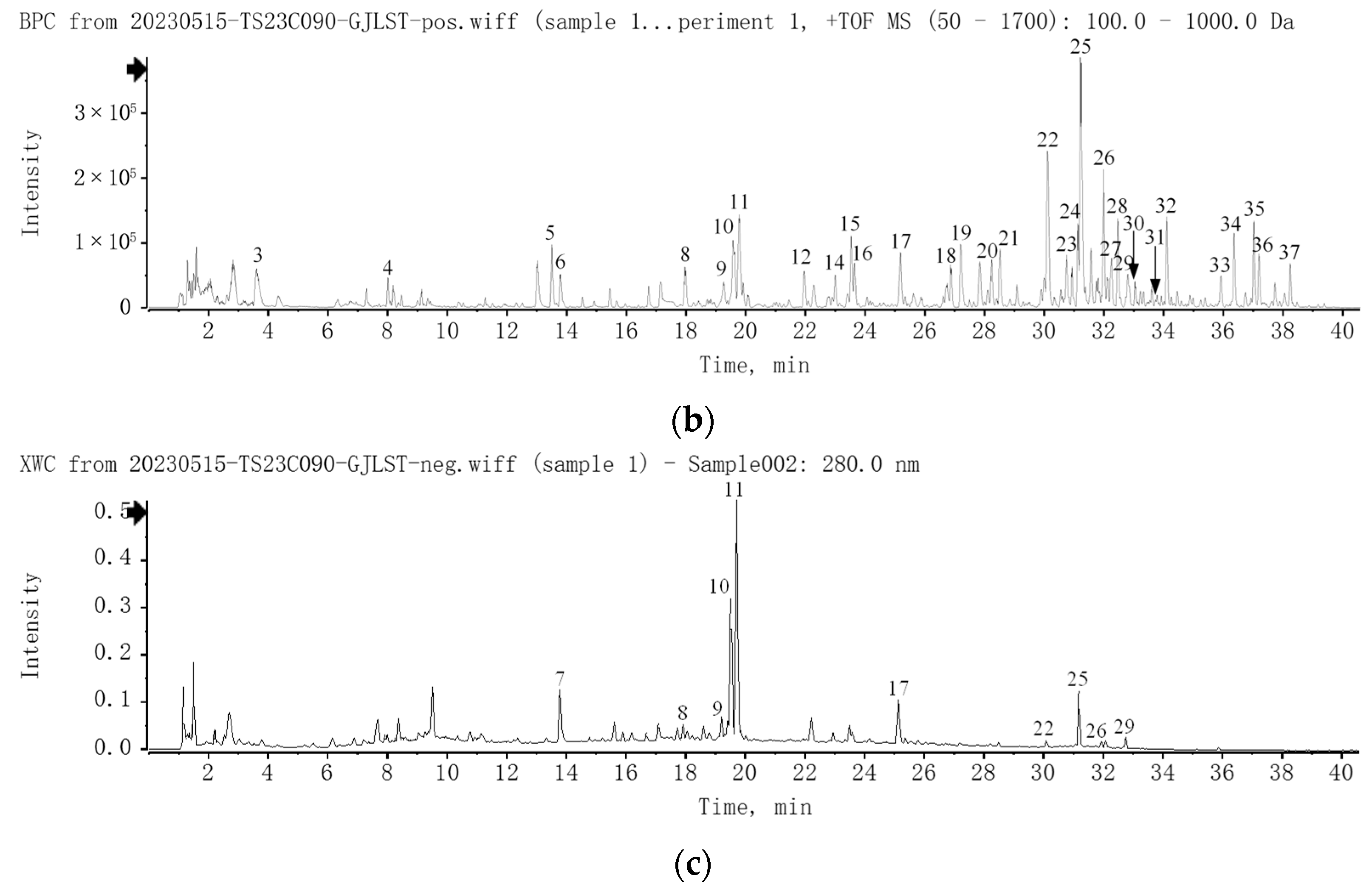
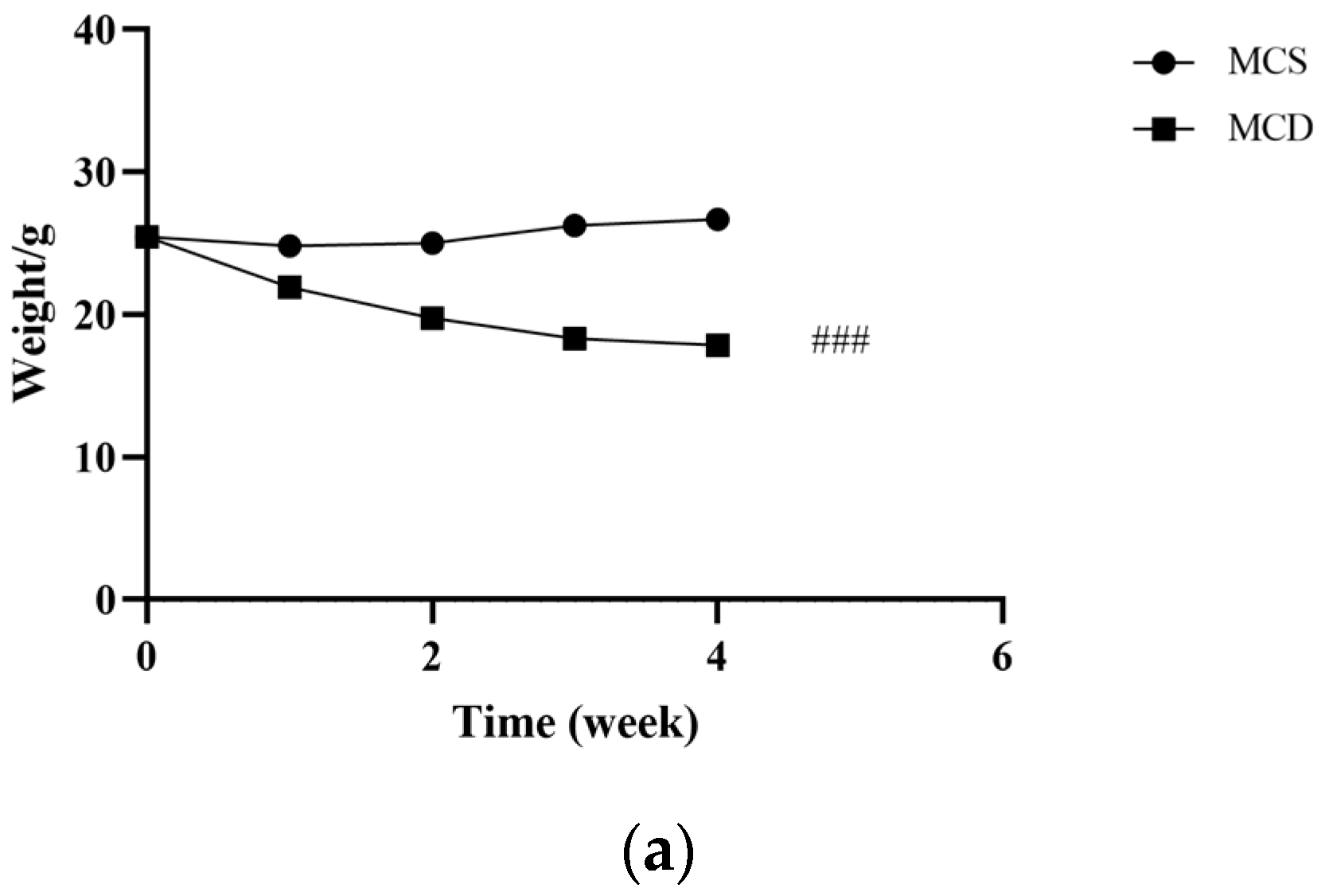

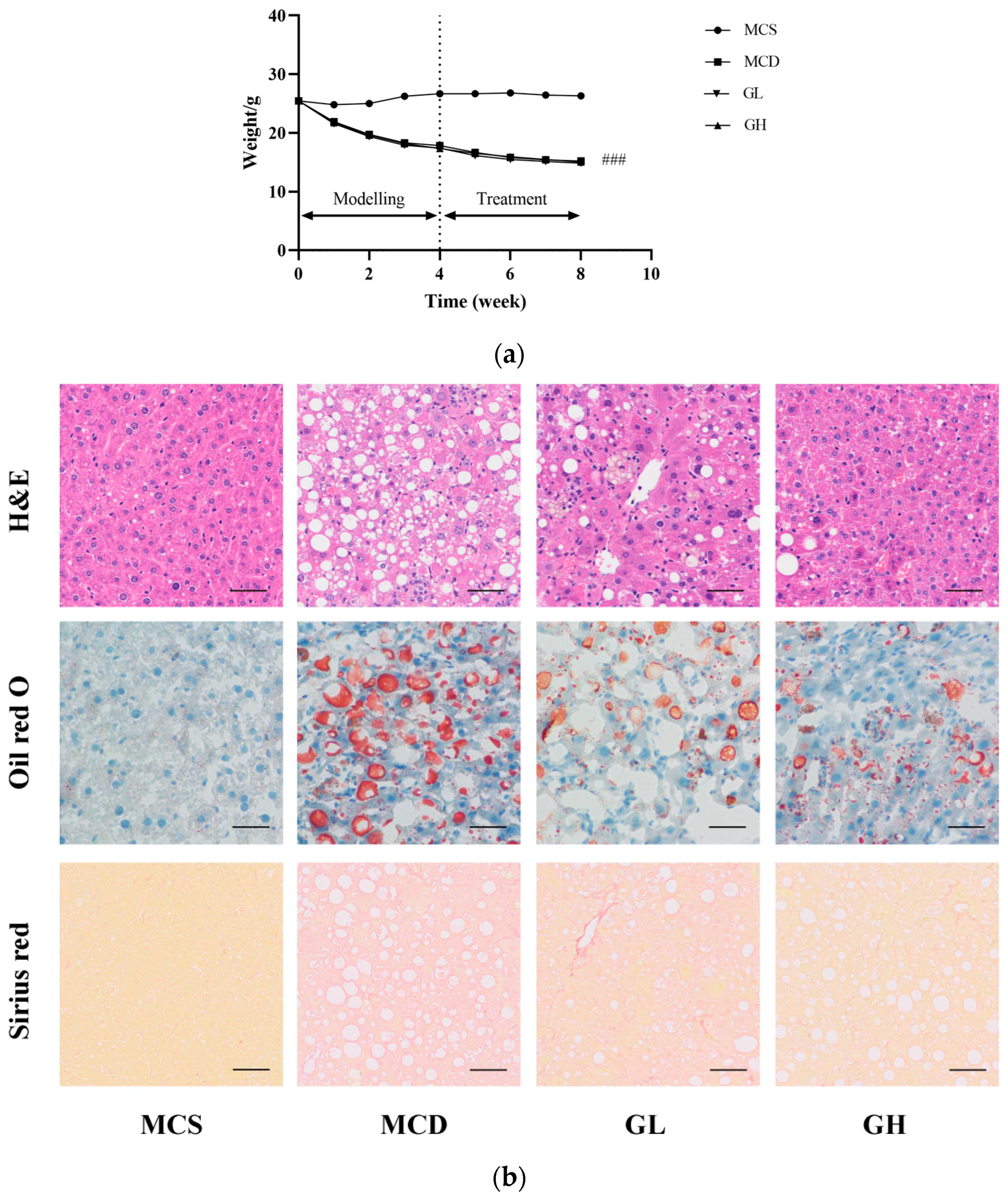

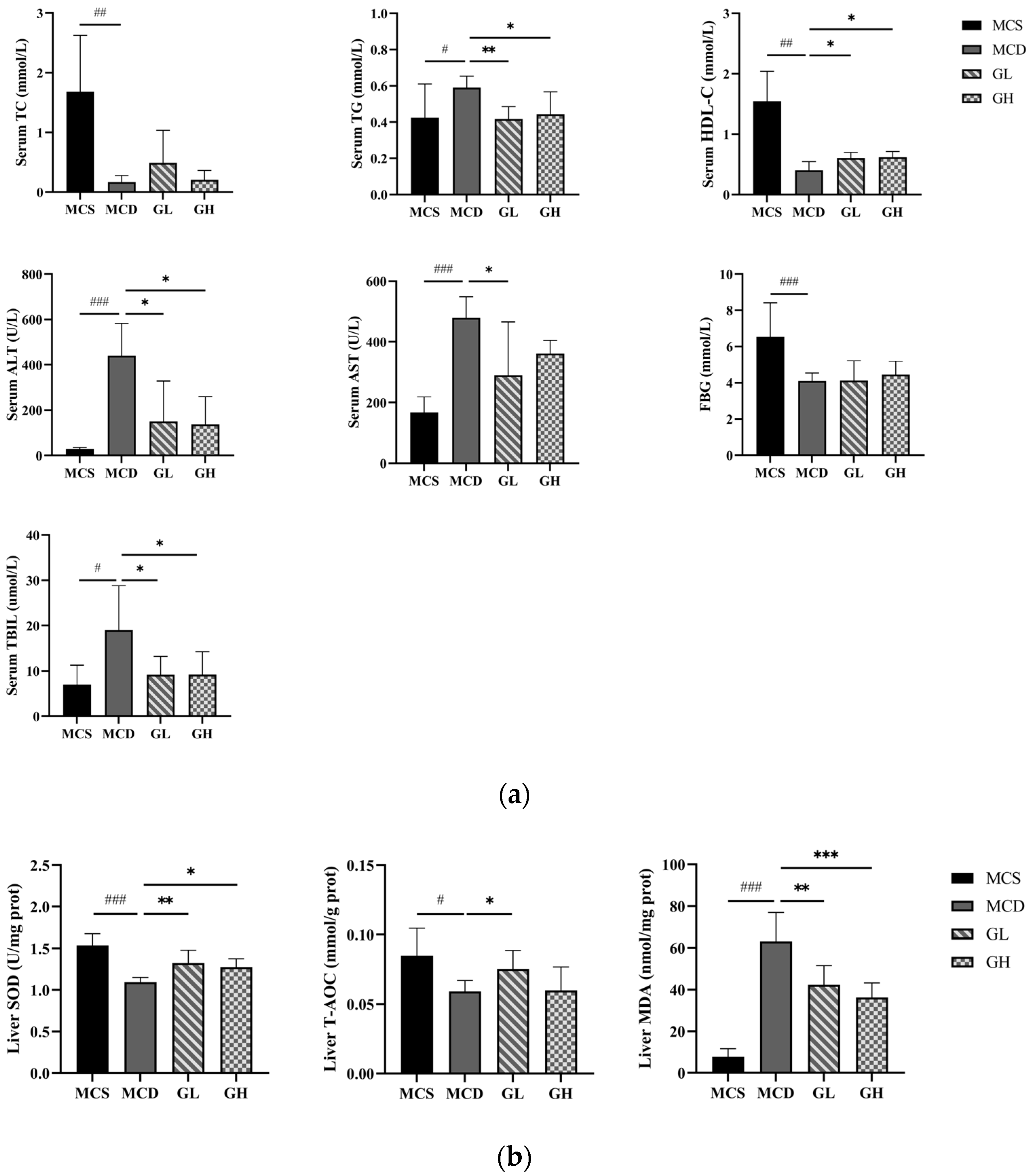
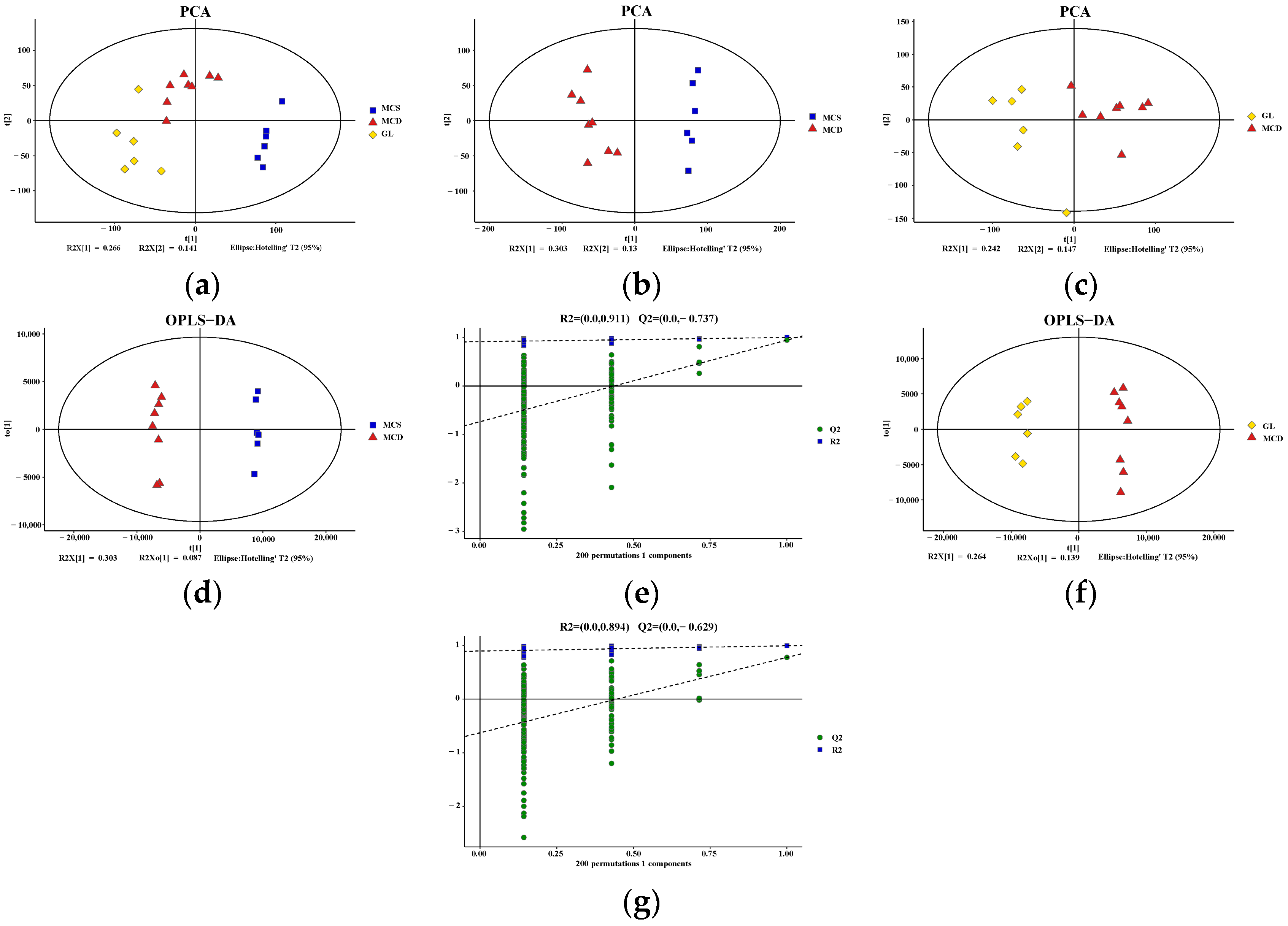
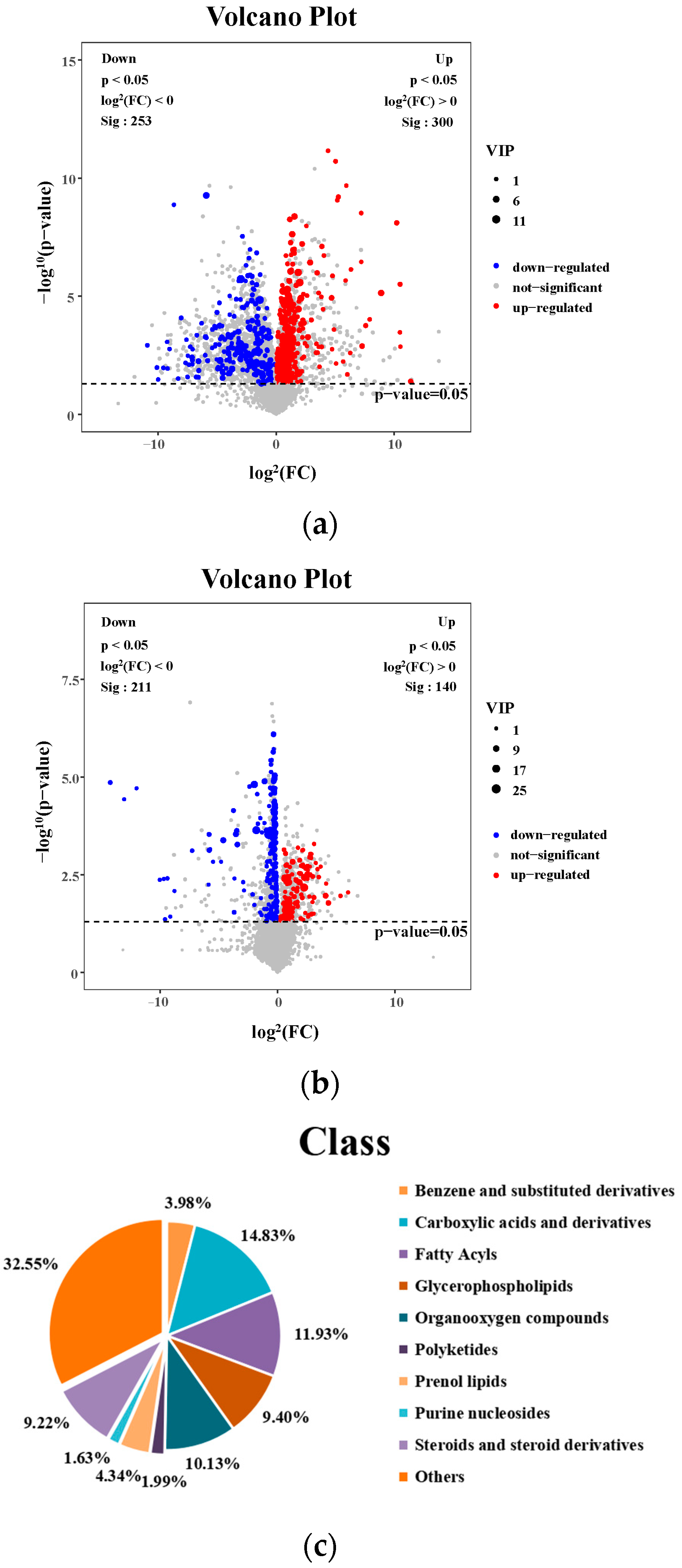
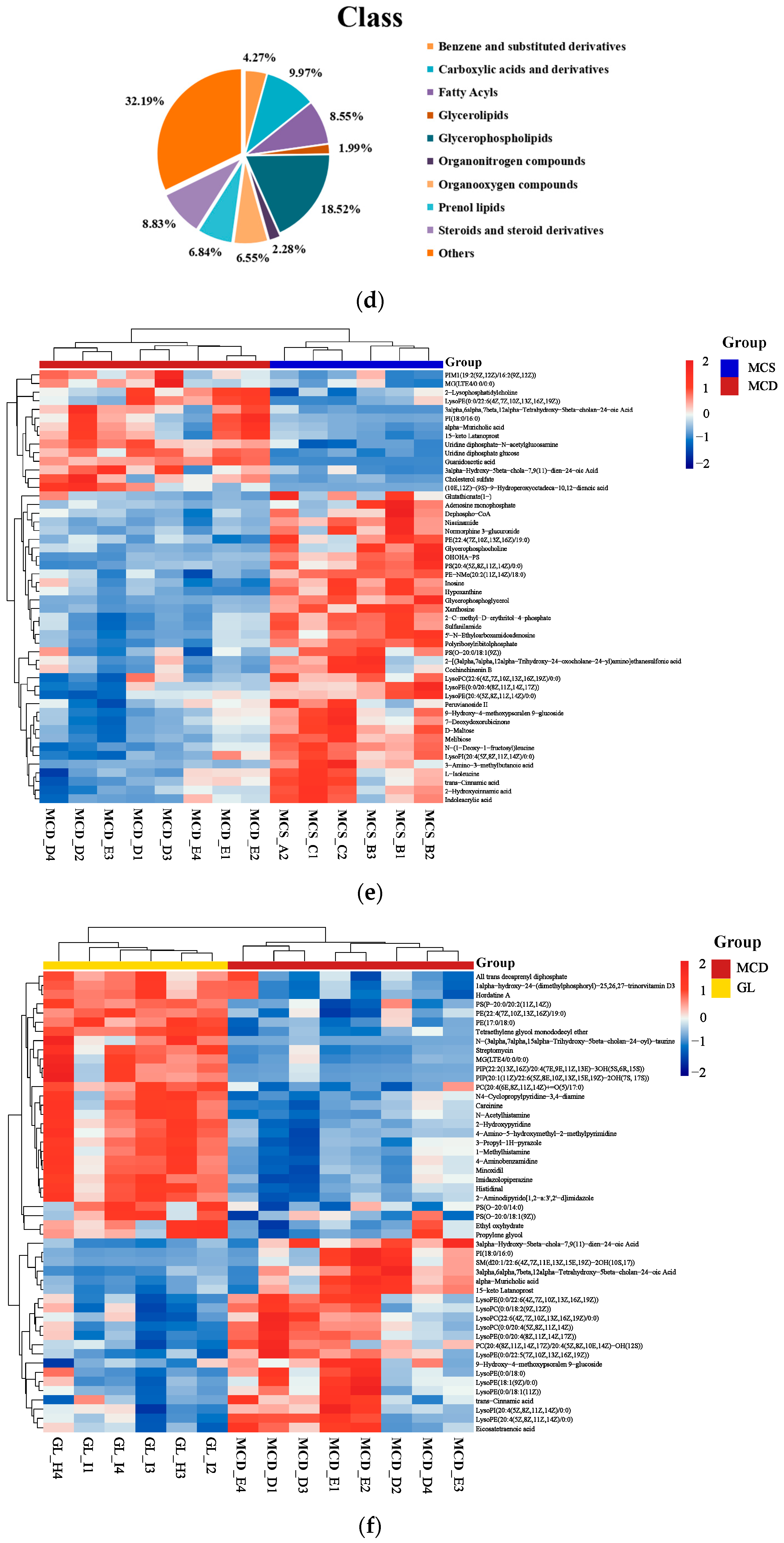
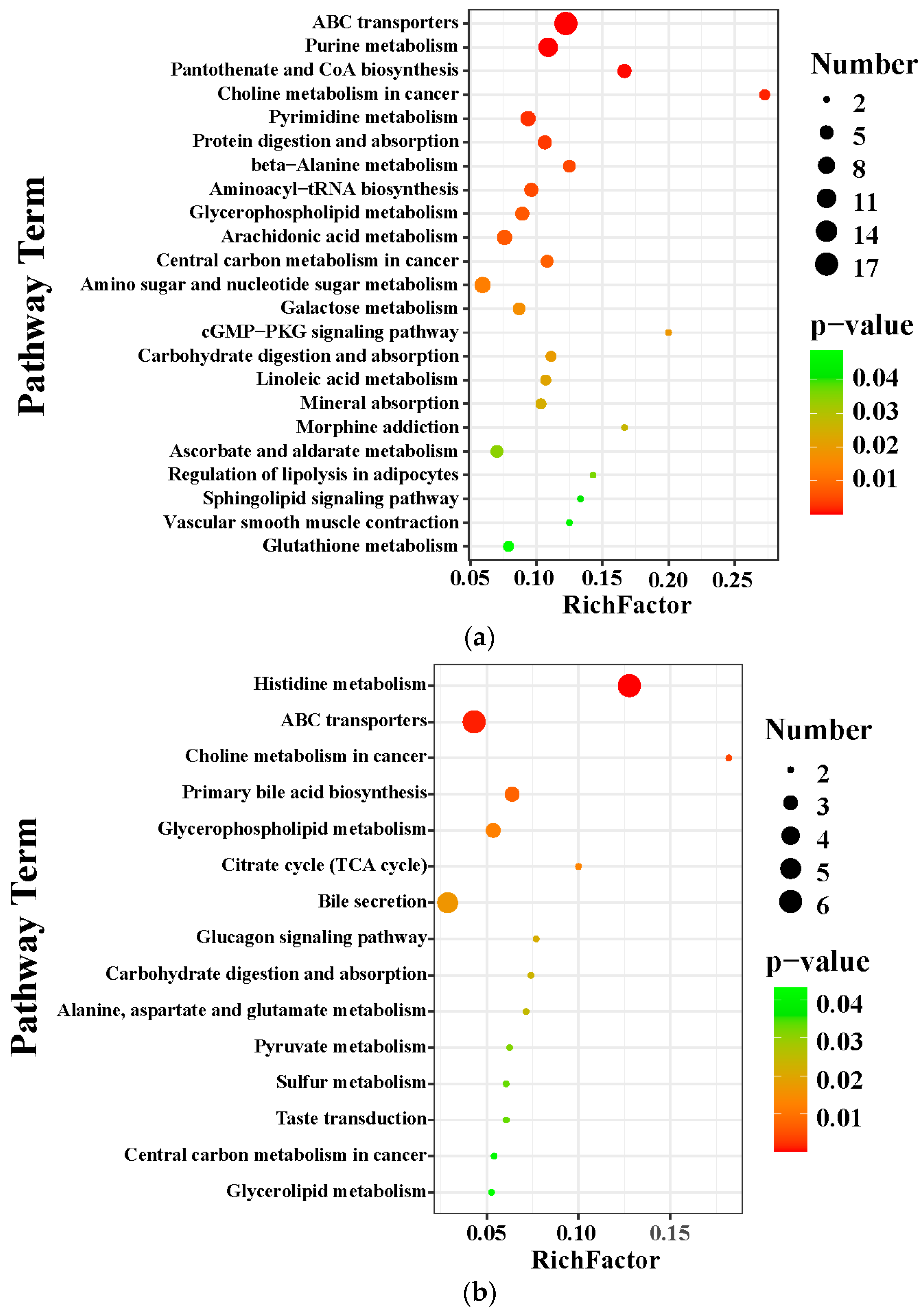

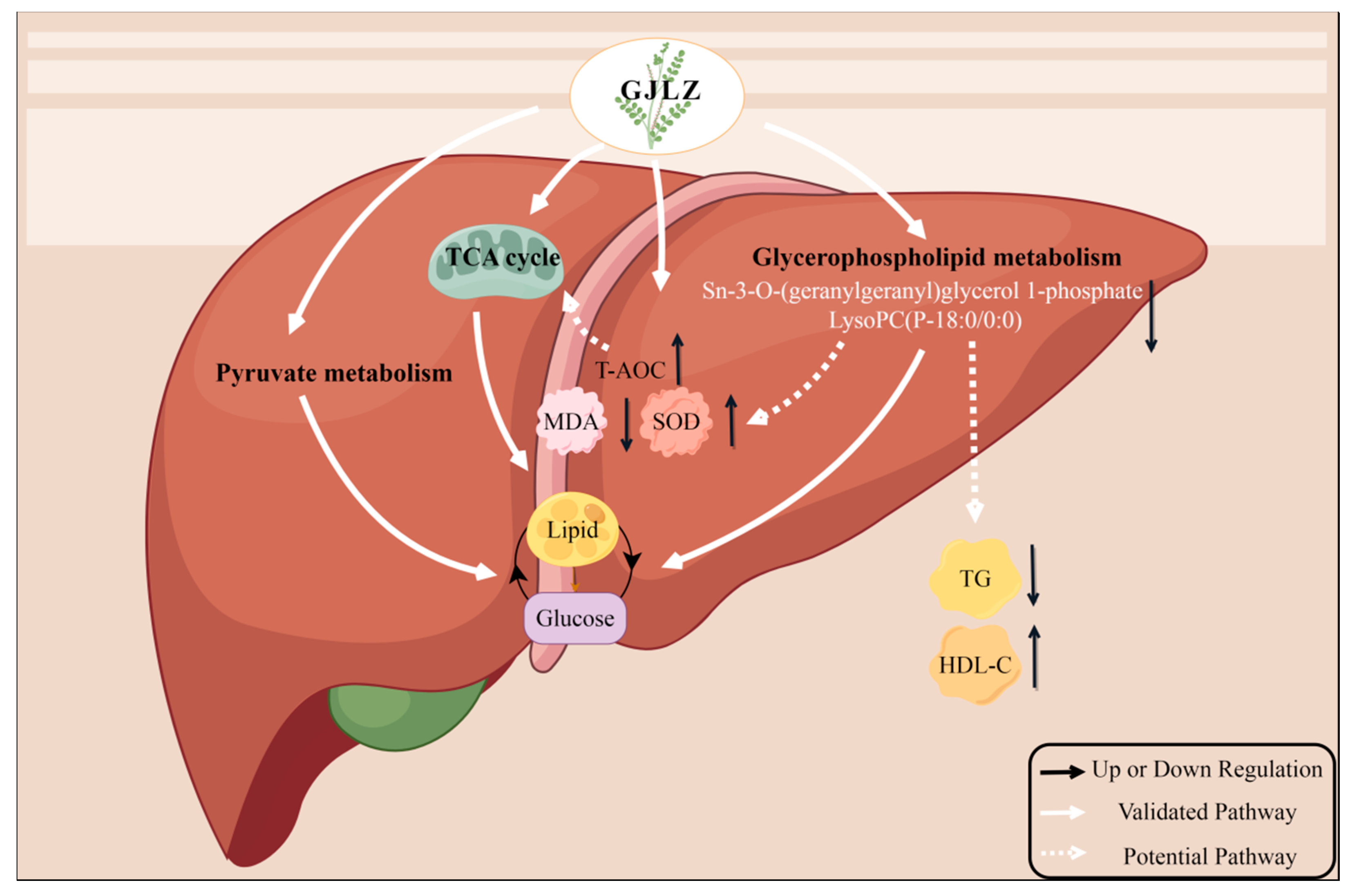
| m/z | Retention Time (min) | Ion Mode | Formula | Metabolites | VIP | p-Value | FC | |
|---|---|---|---|---|---|---|---|---|
| MCS vs. MCD | MCD vs. GL | |||||||
| 453.2860415 | 7.848233333 | neg | C24H40O5 | alpha-Muricholic acid | 16.06769146 | 0.001366585 | 0.226549791 | 4.844474413 |
| 854.5920444 | 11.47483333 | neg | C46H84NO8P | PE(22:4(7Z,10Z,13Z,16Z)/19:0) | 11.85212432 | 0.000161857 | 1.861265702 | 0.653574112 |
| 373.2735342 | 8.718383333 | pos | C24H36O3 | 3alpha-Hydroxy-5beta-chola-7,9(11)-dien-24-oic Acid | 10.53291874 | 0.001324031 | 0.254796555 | 4.932638804 |
| 469.2808627 | 6.996783333 | neg | C24H40O6 | 3alpha,6alpha,7beta,12alpha-Tetrahydroxy-5beta-cholan-24-oic Acid | 9.722835203 | 0.00032875 | 0.108749729 | 5.89703359 |
| 786.6001094 | 12.6016 | pos | C44H86NO9P | PS(O-20:0/18:1(9Z)) | 9.283616715 | 0.016021262 | 1.313988022 | 0.796299615 |
| 526.2928203 | 10.2723 | pos | C27H44NO7P | LysoPE(0:0/22:6(4Z,7Z,10Z,13Z,16Z,19Z)) | 9.248142084 | 0.002656101 | 0.589762419 | 1.94542687 |
| 475.2678339 | 7.848233333 | neg | C26H38O5 | 15-keto Latanoprost | 7.181839741 | 0.001131022 | 0.312034456 | 3.641811108 |
| 837.5497715 | 7.848233333 | neg | C43H83O13P | PI(18:0/16:0) | 5.834670211 | 0.002426321 | 0.074756485 | 17.15141474 |
| 113.0713445 | 14.8042 | pos | C5H5NO | 2-Hydroxypyridine | 5.509739735 | 7.52517 × 10−6 | 1.075065689 | 0.845072861 |
| 165.113551 | 14.23996667 | pos | C8H14N4O | Carcinine | 5.38750534 | 0.000454935 | 1.071885203 | 0.879479787 |
| TG | HDL-C | ALT | AST | TBIL | SOD | T-AOC | MDA | |
|---|---|---|---|---|---|---|---|---|
| sn-3-O-(geranylgeranyl)glycerol 1-phosphate | 0.560 * | −0.443 | 0.475 | 0.569 * | 0.29 | −0.624 ** | −0.354 | 0.649 ** |
| LysoPC(P-18:0/0:0) | 0.362 | −0.896 ** | 0.741 ** | 0.800 ** | 0.293 | −0.706 ** | −0.737 ** | 0.738 ** |
Disclaimer/Publisher’s Note: The statements, opinions and data contained in all publications are solely those of the individual author(s) and contributor(s) and not of MDPI and/or the editor(s). MDPI and/or the editor(s) disclaim responsibility for any injury to people or property resulting from any ideas, methods, instructions or products referred to in the content. |
© 2024 by the authors. Licensee MDPI, Basel, Switzerland. This article is an open access article distributed under the terms and conditions of the Creative Commons Attribution (CC BY) license (https://creativecommons.org/licenses/by/4.0/).
Share and Cite
Tang, N.; Ji, L.; Shi, X.; Xiong, Y.; Xiong, X.; Zhao, H.; Song, H.; Wang, J.; Zhang, L.; You, S.; et al. Effects of Ganjianglingzhu Decoction on Lean Non-Alcoholic Fatty Liver Disease in Mice Based on Untargeted Metabolomics. Pharmaceuticals 2024, 17, 502. https://doi.org/10.3390/ph17040502
Tang N, Ji L, Shi X, Xiong Y, Xiong X, Zhao H, Song H, Wang J, Zhang L, You S, et al. Effects of Ganjianglingzhu Decoction on Lean Non-Alcoholic Fatty Liver Disease in Mice Based on Untargeted Metabolomics. Pharmaceuticals. 2024; 17(4):502. https://doi.org/10.3390/ph17040502
Chicago/Turabian StyleTang, Nan, Lei Ji, Xinyu Shi, Yalan Xiong, Xinying Xiong, Hanhua Zhao, Hualing Song, Jianying Wang, Lei Zhang, Shengfu You, and et al. 2024. "Effects of Ganjianglingzhu Decoction on Lean Non-Alcoholic Fatty Liver Disease in Mice Based on Untargeted Metabolomics" Pharmaceuticals 17, no. 4: 502. https://doi.org/10.3390/ph17040502
APA StyleTang, N., Ji, L., Shi, X., Xiong, Y., Xiong, X., Zhao, H., Song, H., Wang, J., Zhang, L., You, S., Ji, G., Liu, B., & Wu, N. (2024). Effects of Ganjianglingzhu Decoction on Lean Non-Alcoholic Fatty Liver Disease in Mice Based on Untargeted Metabolomics. Pharmaceuticals, 17(4), 502. https://doi.org/10.3390/ph17040502





